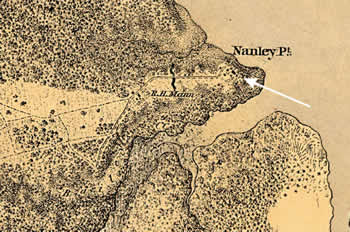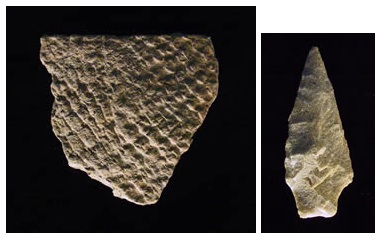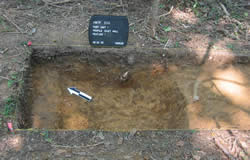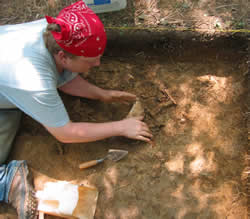Bailey's Creek
The property occupied by Hopewell's wastewater treatment plant at the confluence of Bailey's Creek and the James River had a high potential for important archaeology. Of particular interest was the prospect of contact-period Indian occupation, as well as 17th century English sites. Preliminary scouting of the area also revealed the presence of a late 18th/early 19th century plantation site. Although extensive areas had been previously impacted by relic collectors, there were indications that some portions remain intact.
Survey
Systematic shovel test survey of sections of the wooded portions of this property were carried out. A total of 98 shovel tests were placed at 15 m (50 ft) intervals and all fill was screened for artifacts. Most tests yielded artifacts in differing quantities and of different types. Most common are prehistoric Indian, stone artifacts, but fragments of pottery were numerous as well in certain areas. These artifacts document use of the site for several thousand years but, importantly, also at the time of early English contact.
Important evidence of 17th century English occupation was recovered, too. A small number of shovel tests in one part of the site yielded tobacco pipe fragments diagnostic of this period of occupation. This area deserves more intensive investigation.
 Photo (right): During the Civil War, the north bank of Bailey's Creek was a strategic position for Union forces protecting the massive depot at City Point. Military correspondence refers to various units stationed there, including a cavalry depot in July 1864. Archaeological traces of their stay were found near the old plantation house (see arrow) at Nanley Point. Among the artifacts from a trench feature were a cavalry issue bridle bit, a horseshoe, and minie bullets.
Photo (right): During the Civil War, the north bank of Bailey's Creek was a strategic position for Union forces protecting the massive depot at City Point. Military correspondence refers to various units stationed there, including a cavalry depot in July 1864. Archaeological traces of their stay were found near the old plantation house (see arrow) at Nanley Point. Among the artifacts from a trench feature were a cavalry issue bridle bit, a horseshoe, and minie bullets.
The ante-bellum plantation site has been heavily impacted but there is a chance intact deposits remain for study. In addition to a brick-lined well, a possible cellar was identified. Copious quantities of artifacts discarded by relic collectors at a potential cellar date the occupation mainly to the early 19th century. The variety and types of ceramics are indicative of a family of some means. This feature also warrants some further investigation.
In the remote western section of the wastewater treatment plant property, a prominent natural elevation in the swamp yielded impressive quantities of prehistoric Indian artifacts. One large stone point, dating from around 3000 BC, was found deeply buried in the sandy soil. The depth of the find, approaching 3 feet below the surface, indicates that the site has important potential for intact deposits and a long, stratified record of human activity. The deeply buried artifacts covered by fine sand indicate that this elevated feature surrounded by wetland is the remnant of an old dune formation. Pottery from the site dates the occupation after AD 1.
Photo: Through radiocarbon dating and by comparing collections from hundreds of sites,  archaeologists have gradually classified a large number of regional prehistoric artifact types. Styles of pottery and stone tools especially varied through time and across regions. This variation allows these artifacts to be identified and dated based on their appearance and manufacturing technique. The artifacts above were identified using this type system. Based on the net-impressed surface treatment and the grit used as temper, the pottery sherd above is probably a Popes Creek type (about 2000 years old). The shape of this quartzite spear point identifies it as a Bare Island type (5000 years old).
archaeologists have gradually classified a large number of regional prehistoric artifact types. Styles of pottery and stone tools especially varied through time and across regions. This variation allows these artifacts to be identified and dated based on their appearance and manufacturing technique. The artifacts above were identified using this type system. Based on the net-impressed surface treatment and the grit used as temper, the pottery sherd above is probably a Popes Creek type (about 2000 years old). The shape of this quartzite spear point identifies it as a Bare Island type (5000 years old).
Testing
The results of our earlier survey closer to the confluence of Bailey Creek and the James River drew us back for more intensive testing. Shovel tests in this area had yielded a few telltale pipe fragments from the early colonial period (17th century). A single 1 x 2 meter test unit was placed near one shovel test that produced such a smoking pipe fragment to increase the sample of artifacts and confirm that an early English occupation was indeed present. The unit not only generated a sizable collection of second to third quarter, 17th century artifacts (ca. 1630-1670), but an intact Civil War feature was documented as well. The colonial artifacts consist mainly of more tobacco pipe fragments (including one of Dutch make) and a few ceramic sherds. The site appears to have been occupied during the early "tobacco boom" in Tidewater Virginia.
The Civil War feature is a trench of uncertain function (possibly for defense or for drainage) filled with Union army debris. Among the associated artifacts are several unfired Minie balls, a bridle bit, buttons, and animal bone. A quick search of the Official Records offers evidence that cavalry units were posted near Bailey Creek and perhaps this feature is associated with that occupation. The presence of an undisturbed feature bodes well for the research potential of this important site.
Photos below: Excavation of the fill revealed part of a shallow trench, perhaps dug by Union pickets for defensive purposes. Various Civil War-era artifacts were recovered, including an inkwell, a horseshoe, a cavalry bridle bit, and several minie bullets.


















